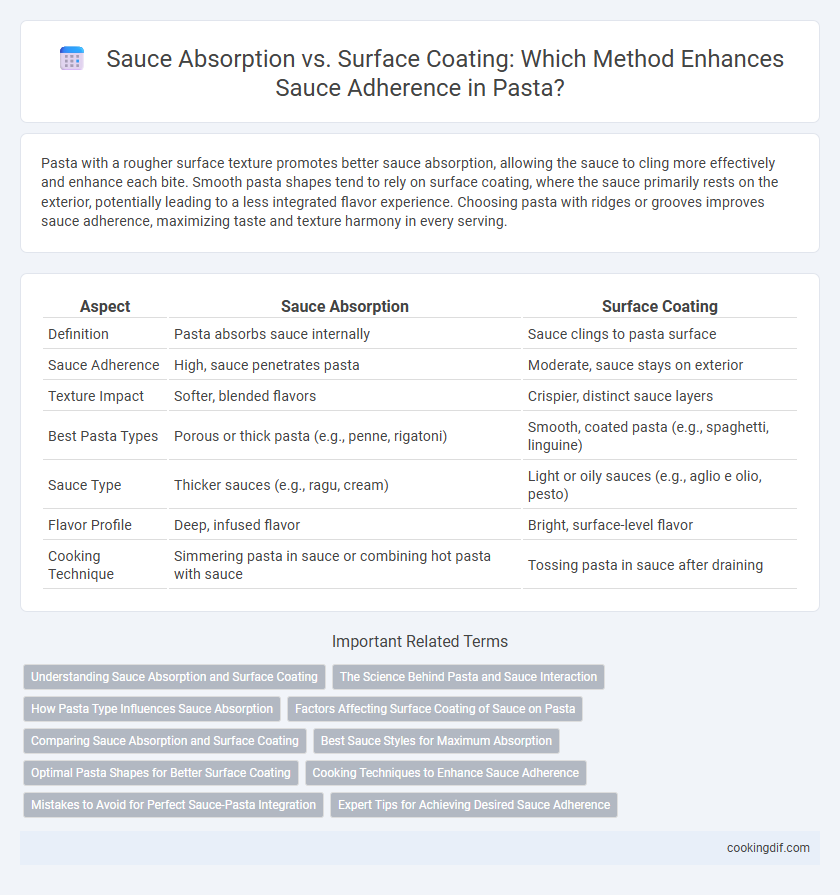Pasta with a rougher surface texture promotes better sauce absorption, allowing the sauce to cling more effectively and enhance each bite. Smooth pasta shapes tend to rely on surface coating, where the sauce primarily rests on the exterior, potentially leading to a less integrated flavor experience. Choosing pasta with ridges or grooves improves sauce adherence, maximizing taste and texture harmony in every serving.
Table of Comparison
| Aspect | Sauce Absorption | Surface Coating |
|---|---|---|
| Definition | Pasta absorbs sauce internally | Sauce clings to pasta surface |
| Sauce Adherence | High, sauce penetrates pasta | Moderate, sauce stays on exterior |
| Texture Impact | Softer, blended flavors | Crispier, distinct sauce layers |
| Best Pasta Types | Porous or thick pasta (e.g., penne, rigatoni) | Smooth, coated pasta (e.g., spaghetti, linguine) |
| Sauce Type | Thicker sauces (e.g., ragu, cream) | Light or oily sauces (e.g., aglio e olio, pesto) |
| Flavor Profile | Deep, infused flavor | Bright, surface-level flavor |
| Cooking Technique | Simmering pasta in sauce or combining hot pasta with sauce | Tossing pasta in sauce after draining |
Understanding Sauce Absorption and Surface Coating
Sauce absorption occurs when pasta porosity allows liquid to penetrate, enhancing flavor infusion within each strand or piece. Surface coating involves the sauce clinging to the pasta exterior, primarily influenced by the pasta's texture and starch content, which creates a sticky layer for better adherence. Optimal sauce adherence balances absorption with coating, depending on factors like pasta type, cooking method, and sauce viscosity.
The Science Behind Pasta and Sauce Interaction
Sauce absorption in pasta occurs when the starch molecules gelatinize and trap the sauce within the pasta strands, enhancing flavor penetration and texture. Surface coating relies on the pasta's rough or porous exterior, often created by bronze-cutting methods, which increases adherence by providing microscopic grooves that hold the sauce. Understanding this interaction highlights the importance of pasta texture and cooking time in achieving optimal sauce adherence and flavor balance.
How Pasta Type Influences Sauce Absorption
Pasta shape and texture significantly influence sauce absorption and surface coating efficacy, with porous or ridged varieties like rigatoni and fusilli enhancing sauce adherence through increased surface area. Smooth, thin pastas such as angel hair primarily rely on surface coating rather than absorption, making them ideal for lighter, oil-based sauces. Understanding these qualities ensures optimal pairing of pasta type with sauce consistency, maximizing flavor integration and overall dish satisfaction.
Factors Affecting Surface Coating of Sauce on Pasta
Surface coating of sauce on pasta is primarily influenced by pasta texture, sauce viscosity, and cooking methods. Rough or ridged pasta surfaces increase sauce adherence by providing greater contact area, while thicker sauces cling better due to higher viscosity. Properly draining pasta without rinsing preserves surface starch, enhancing sauce absorption and creating optimal flavor integration.
Comparing Sauce Absorption and Surface Coating
Sauce absorption in pasta occurs when the starch granules swell and absorb moisture, allowing deeper flavor infusion and a more uniform taste throughout each bite. Surface coating relies on the pasta's texture, such as ridges or grooves, to hold sauce externally, providing bursts of concentrated flavor with each mouthful. Comparing the two, absorption enhances flavor integration and sauce retention internally, while coating offers distinctive texture contrast and varied taste intensity on the pasta's surface.
Best Sauce Styles for Maximum Absorption
Sauce absorption relies heavily on pasta types with porous or ridged surfaces, such as penne rigate or fusilli, which trap sauce within their grooves, enhancing flavor intensity. Creamy and thicker sauces with cheese or cream base adhere well to smooth pasta like fettuccine, providing a surface coating effect rather than deep absorption. Tomato-based and oil-based sauces benefit from both absorption and coating, but robust, chunkier sauces best complement ridged pasta shapes for maximum adherence and taste penetration.
Optimal Pasta Shapes for Better Surface Coating
Optimal pasta shapes for better sauce adherence feature textured surfaces, grooves, and ridges that enhance sauce absorption and retention. Varieties such as rigatoni, penne, and fusilli offer increased surface area and crevices that trap thicker sauces, improving flavor distribution. Smooth pasta types like spaghetti provide less sauce adherence, making textured shapes preferable for richer, creamier sauces.
Cooking Techniques to Enhance Sauce Adherence
Proper cooking techniques significantly influence sauce adherence by enhancing the pasta's surface texture and porosity. Slightly undercooking pasta to maintain a firm, al dente texture allows the starches to retain their binding properties, promoting better sauce absorption rather than mere surface coating. Tossing pasta immediately after cooking with a small amount of its starchy cooking water helps create an emulsion that improves sauce clinging and flavor integration.
Mistakes to Avoid for Perfect Sauce-Pasta Integration
Using pasta with an overly smooth surface reduces sauce adherence, causing the sauce to slip off rather than integrate, which diminishes flavor in every bite. Avoid rinsing pasta after boiling, as this removes the starch that helps sauce absorption and binding. Undercooking pasta leaves it too firm for sauce absorption, while overcooking creates a mushy texture resisting proper coating--aiming for al dente ensures ideal sauce adhesion.
Expert Tips for Achieving Desired Sauce Adherence
Expert tips for achieving optimal sauce adherence emphasize the balance between sauce absorption and surface coating. Pasta with porous or rough textures, such as ridged penne or rigatoni, enhances sauce absorption by allowing the sauce to penetrate and cling better. Meanwhile, smoother pasta shapes like spaghetti favor surface coating, where the sauce adheres to the exterior, requiring the sauce's consistency to be carefully adjusted for ideal cling and flavor integration.
sauce absorption vs surface coating for sauce adherence Infographic

 cookingdif.com
cookingdif.com